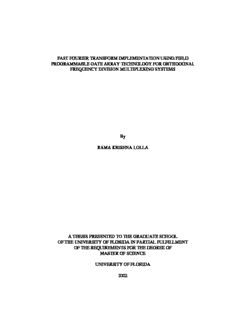Table Of ContentFAST FOURIER TRANSFORM IMPLEMENTATION USING FIELD
PROGRAMMABLE GATE ARRAY TECHNOLOGY FOR ORTHOGONAL
FREQUENCY DIVISION MULTIPLEXING SYSTEMS
By
RAMA KRISHNA LOLLA
A THESIS PRESENTED TO THE GRADUATE SCHOOL
OF THE UNIVERSITY OF FLORIDA IN PARTIAL FULFILLMENT
OF THE REQUIREMENTS FOR THE DEGREE OF
MASTER OF SCIENCE
UNIVERSITY OF FLORIDA
2002
Copyright 2002
by
RAMA KRISHNA LOLLA
To
My Family
&
BABA
ACKNOWLEDGMENTS
I would like to extend my thanks to Dr. Fred J. Taylor for his suggestions at all the
stages of the project. This project would not have taken shape without his guidance.
I would like to thank my advisors, Dr. John G. Harris and Dr. John M. Shea, for their
timely suggestions. I am also thankful to my colleagues in the High Speed Digital
Architecture Laboratory for their support.
I would also like to acknowledge the continuous support my family has given me
during the course of my work.
iv
TABLE OF CONTENTS
page
ACKNOWLEDGMENTS..................................................................................................iv
LIST OF TABLES............................................................................................................vii
LIST OF FIGURES..........................................................................................................viii
ABSTRACT.......................................................................................................................ix
CHAPTER
1 INTRODUCTION...........................................................................................................1
OFDM Overview.................................................................................................................1
FFT Algorithms Explored...................................................................................................2
Thesis Organization.............................................................................................................3
2 OFDM THEORY AND IMPLEMENTATION..............................................................4
Description of the Wireless Channel...................................................................................4
History of OFDM................................................................................................................6
3 ALGORITHM THEORY AND DESCRIPTION...........................................................9
Cooley-Tukey Algorithm....................................................................................................9
Complexity Analysis..............................................................................................12
Radix-2 Algorithm.................................................................................................13
Radix-4 Algorithm.................................................................................................15
Chirp-z Algorithm.............................................................................................................17
4 FIELD PROGRAMMABLE GATE ARRAYS............................................................24
Power Calculations in FPGAs...........................................................................................27
Costs Involved in FPGA Fabrication................................................................................27
Comparison to other Technologies...................................................................................28
5 IMPLEMENTATION DETAILS AND RESULTS.....................................................29
Description of the Work....................................................................................................29
Description of Tools Used.................................................................................................32
v
Results and Conclusions...................................................................................................33
Power Calculations............................................................................................................35
Noise Tolerance.................................................................................................................37
Directions of Future Work................................................................................................40
APPENDIX
A 16-BIT COOLEY-TUKEY IMPLEMENTATION.....................................................41
B 32-BIT COOLEY-TUKEY AND CHIRP-Z IMPLEMENTATION...........................64
LIST OF REFERENCES................................................................................................105
BIOGRAPHICAL SKETCH ..........................................................................................107
vi
LIST OF TABLES
Table page
3.1 Time-domain index n resolved in terms of n1 and n2.................................................11
3.2 Resolution of the frequency domain index k..............................................................11
4.1 Truth table of the function implemented in Figure (4.3).............................................26
5.1 Radix–2 Cooley-Tukey implementation with round off errors...................................33
5.2 Radix-4 Cooley Tukey implementation with round off errors....................................33
5.3 Radix-2 Cooley Tukey implementation without round off errors...............................34
5.4 Radix-4 Cooley-Tukey implementation without round off errors..............................34
5.5 Power calculations for Radix-2 8-point FFT...............................................................36
vii
LIST OF FIGURES
Figure page
2.1 Multipath Propagation...................................................................................................5
2.2 General Block Diagram of an OFDM communication system.....................................6
3.1 Cooley-Tukey Algorithm Implementation..................................................................12
3.2 Radix-2 repetitive unit.................................................................................................14
3.3 Implementation of a Radix-2 8-point FFT unit...........................................................15
3.4 Radix-4 basic block.....................................................................................................16
3.5 Chirp -z implementation.............................................................................................21
3.6 Chirp Signal.................................................................................................................21
3.7 Phase response of the Chirp Signal shown in Figure 3.6............................................22
4.1 General structure of an FPGA.....................................................................................24
4.2 Programmable Interconnection Switch.......................................................................25
4.3 A 3-input LUT implementation..................................................................................25
5.1 Implementation of Multipliers (a) shows the initial truncating configuration and
Figure (b) shows the truncation operation after one more level of processing.....31
5.2 N-by-N-bit Pipelined Multiplier.................................................................................31
5.3 Model used in the Thesis work...................................................................................33
5.4 BER variations against SNR for an internal bus width of 16......................................37
5.5 BER variations against SNR for an internal bus width of 32......................................38
5.6 BER variations against SNR: Comparison of floating point results with modeled
Radix –2 and Radix –4 8 point FFTs with 16- and 32-bit internal bus width.......38
viii
Abstract of Thesis Presented to the Graduate School
of the University of Florida in Partial Fulfillment of the
Requirements for the Degree of Master of Science
FAST FOURIER TRANSFORM IMPLEMENTATION USING FIELD
PROGRAMMABLE GATE ARRAY TECHNOLOGY FOR ORTHOGONAL
FREQUENCY DIVISION MULTIPLEXING SYSTEMS
By
Rama Krishna Lolla
December 2002
Chair: Dr. Fred J. Taylor
Major Department: Electrical and Computer Engineering
Orthogonal Frequency Division Multiplexing (OFDM) is an emerging multi-carrier
technique, which uses Fast Fourier Transforms (FFTs) to modulate the data onto sets of
orthogonal frequencies. The core operation in the OFDM systems is the FFT unit that
consumes a large amount of resources and power. The goal of this thesis was to study
better implementation structures for the FFT. The Radix-2 and Radix-4 implementations
of the Cooley-Tukey algorithm and the Chirp-z algorithm were implemented using the
Field Programmable Gate Array (FPGA) technology. Twos complement numbering
system was used in the designs, and their performance was judged on the basis of their
implementation complexity and amount of power consumed for implementation.
ix
CHAPTER 1
INTRODUCTION
Orthogonal Frequency Division Multiplexing (OFDM) is an emerging Multi-carrier
technique, which uses FFTs to modulate the data onto sets of orthogonal frequencies.
Orthogonality enables the frequencies to overlap while still maintaining statistical
independence. The transmitter uses an IFFT to convert the “frequency domain” data into
the “time domain” and the received signals are converted back into the “frequency
domain” by using an FFT at the receiver. An IFFT is similar in structure to the FFT, the
differences being the twiddle factors in each being the complex conjugates of other [1].
This core operation is often the limiting technology when it comes to the power
consumed for its implementation. The objective of this thesis is to study the
implementations of Cooley-Tukey and Chirp-z FFT algorithms onto FPGA technology to
arrive at a low power, low latency configuration.
OFDM Overview
OFDM efficiently overcomes the problems that plague most wireless channels. Multi-
path propagation is a serious hazard that introduces delay spread accounting for multiple
copies of the transmitted signal to reach the receiver. This causes energy of one symbol
of information to spill onto several successive symbols. This phenomenon is called Inter
Symbol Interference (ISI). OFDM reduces ISI through several simultaneous
transmissions, thus making it possible to have an increase in the transmission time for
each symbol. OFDM moves the equalization operation to the frequency domain instead
of time domain as in the case of single carrier systems.
1
Description:5.2 Radix-4 Cooley Tukey implementation with round off errors technique, which uses Fast Fourier Transforms (FFTs) to modulate the data onto sets of . The algorithms used for the purpose of this thesis work were the Cooley Tukey and better FFT implementation structure for OFDM applications.

